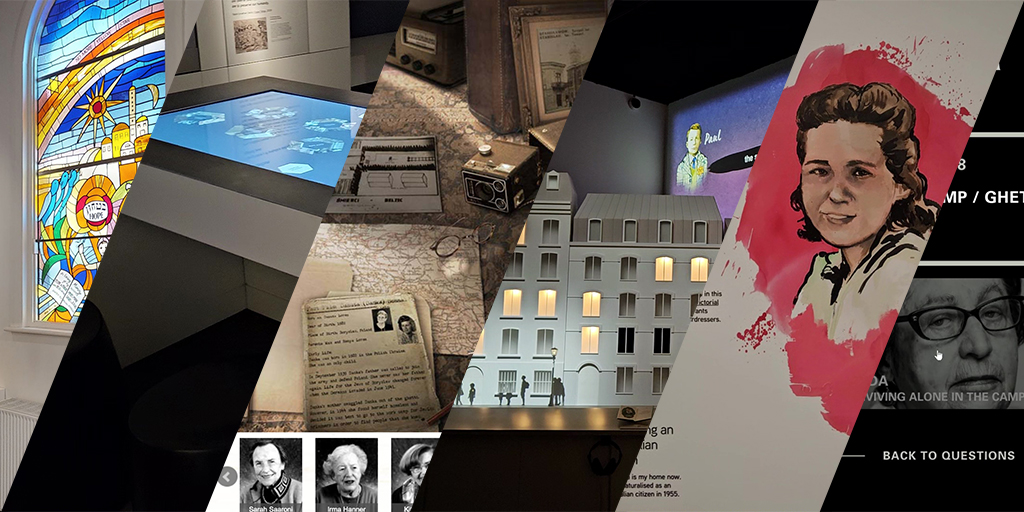
Spotlight on Melbourne Holocaust Museum
by Victoria Grace Walden
In perhaps the most unusual way to return from maternity leave, my first day back involved a 24-hour journey from the UK to Melbourne, Australia (and yes, with the baby!). When I originally got in contact with Anna Hirsh – now Manager of Collections and Research at the museum and the fabulous host of my scholar-in-residence – she was working at what was then called Melbourne’s Jewish Holocaust Centre and in 2020 the site closed its doors for a major refurbishment and rebranding.
A Long History of Multimedia
At that time, staff created a virtual walkthrough of the main exhibition to archive its existence. Now it was closed (as it would have been – pandemic or not), school groups and other visitors could explore its content. This was not just a photo-realist experience of the exhibition space though; it was enhanced by extra video content such as behind-the-scenes moments with curators (Curators’ Corner series) and importantly mini-tours from survivors explaining some of the exhibited materials – much of this additional content came from existing digital projects.
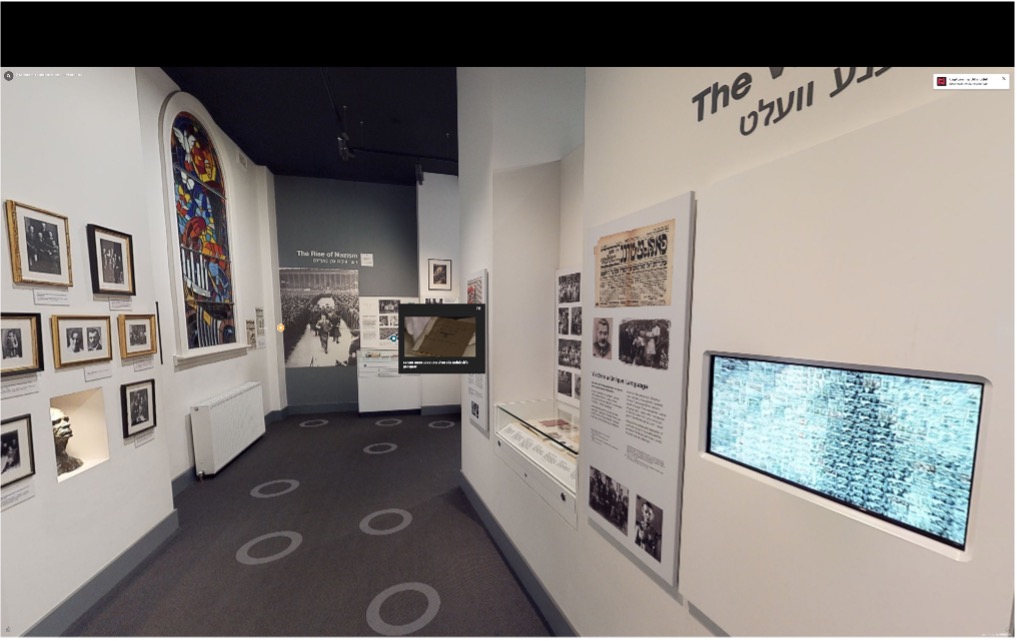
Jewish Holocaust Centre Melbourne Virtual Tour
The centre was established by a survivor community, opening in March 1984. However, as Steven Cooke (now CEO of the museum) and Donna-Lee Frieze emphasise in their book The Interior of Our Memories, its history goes back to the Holocaust, when some of its founders gathered documents in the Łódź Ghetto: collecting material evidence intended for a future audience to see. Another core theme of that book speaks to the transition from centre to museum: if survivors are such a key tenet of Holocaust commemoration and education, what do we do after they pass and how can a centre developed from the ‘bottom-up’ by that community transition into a long-lasting, professional institution that continues to remember them?
Survivor voice has been at the forefront of the centre’s work and remains crucial to the new museum’s identity too. Indeed, looking back through the history of their digital outputs the significance of survivors has always been foregrounded. The first digital projects were survivor-led. For example, Cherished Children invited survivors to bring in photographs of children murdered in the Holocaust, which were scanned, added to the archives and presented originally in a simple PDF slideshow which played on a video screen.
The old exhibition had audio-visual displays based on thematic 1-minute clips of survivors from a project called Eyewitness, for which the centre recorded testimony specifically for broadcast in its exhibition space. To be clear, this was not the traditional long-form testimony interview, but rather structured, guided and edited to be presented in the museum and survivors were prepped accordingly. These short-form videos are available on YouTube today and are still used by the museum. They are just one example of the broad range of work carried out by the centre’s former audio-visual specialist – Robbie Simons. The exhibition also included some map-driven ‘deep dive’ interactives to allow visitors to explore the histories of the Holocaust in specific sites in Europe – an approach to condensing information that is still used in today’s main exhibition.
how do we keep the survivor community at the centre of the museum?
The Jewish Holocaust Centre also hosted a project called StoryPods, which started out as material A4 picture books developed into multimedia touchscreen ‘kiosks’ styled like 1930s desks with personal and archival photographs allowing visitors to explore a wide range of survivor stories in the exhibition. The in-person presence of survivors has always been important to the centre/museum’s work, but before StoryPods, visitors would be guided by one specific individual’s experience – the kiosks shifted perspective so that the decision about which survivor narratives to follow and how to explore them was visitor-led. (That said, survivor-led tours were and still are an important element of the institution’s programme.)
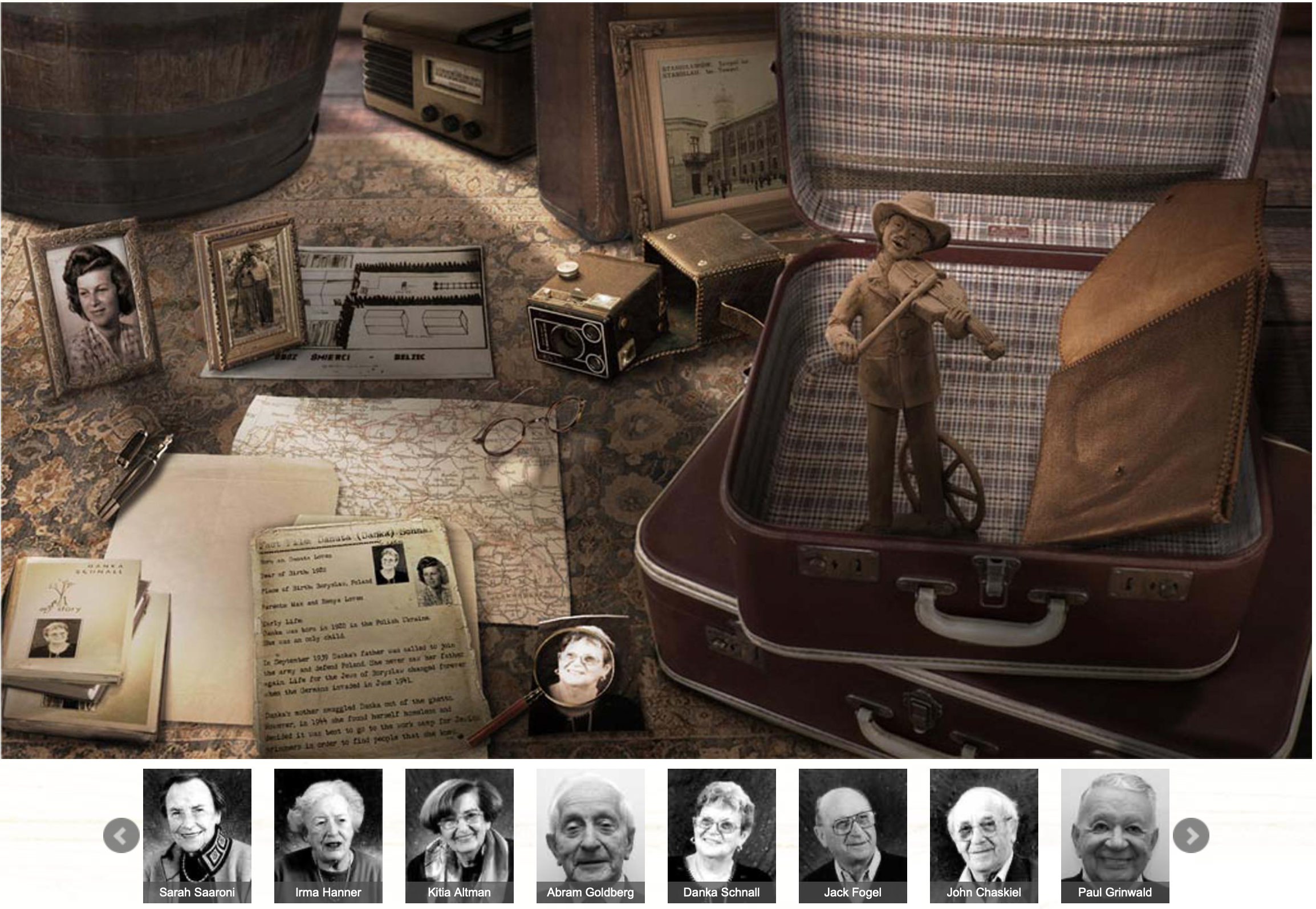
A screenshot of StoryPods online.
Digital media has played a significant role in the museum’s educational outreach too. From DigiBooks – part of an ABC (Australia’s national broadcaster) education initiative on ‘The Beginning of the End’, ‘Ghettos: The Struggle to Live’ and ‘Camps to Liberation’ to activities presented on the museum’s own website: Łódź Ghetto – which aims to foreground artefacts, and Ask a Survivor – expediated by Covid – four survivors responded to Frequently Asked Questions from visitors and Understanding through Testimony – which like Ask a Survivor presents interactive experiences with survivor testimony (arguably extending the earlier work set out with StoryPods which is no longer a feature of the renovated Melbourne Holocaust Museum).
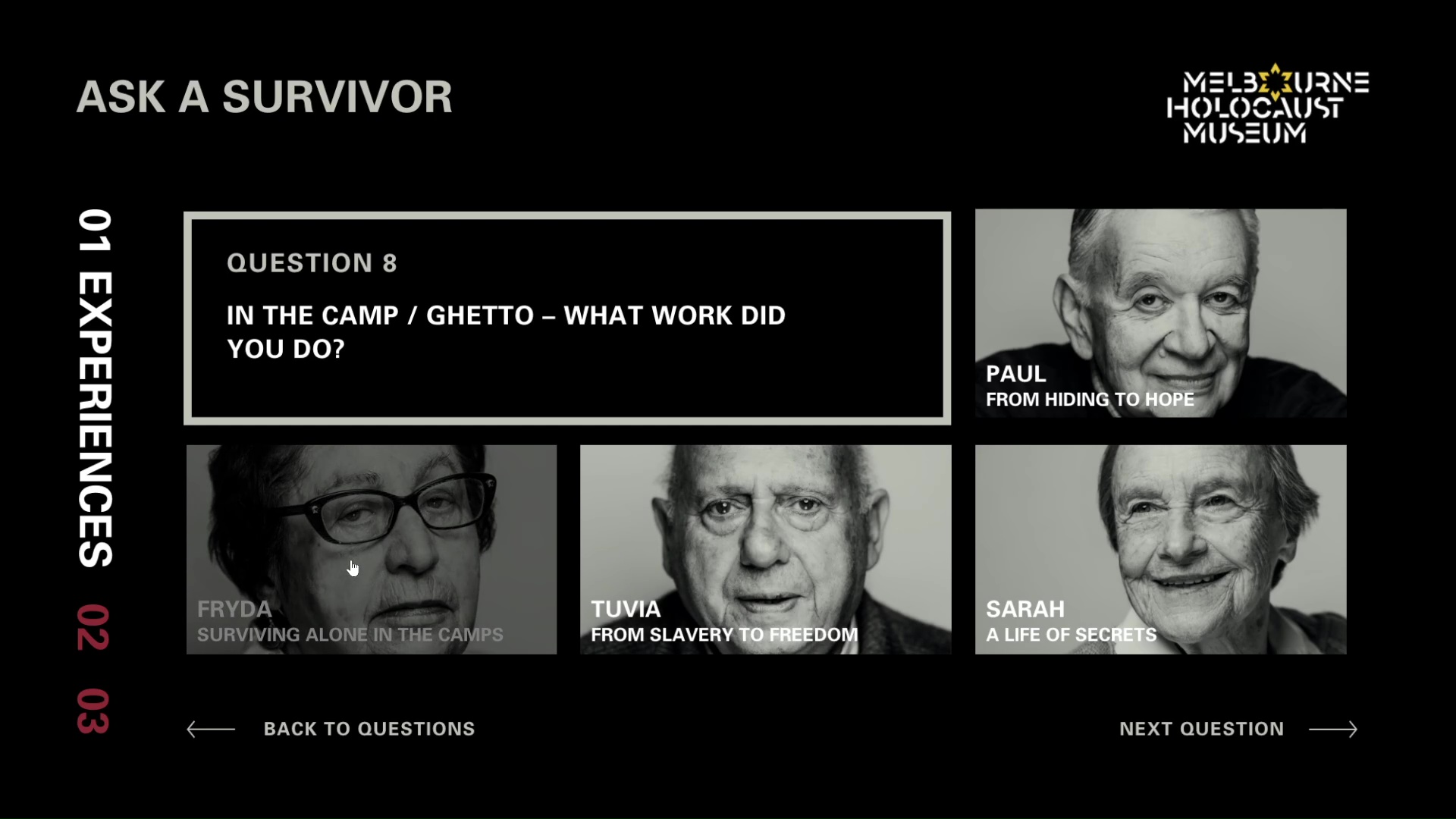
Screenshot – Ask a Survivor
Doing Digital Holocaust Memory in Melbourne
Melbourne of course has no so-called ‘authentic’ historical sites of Holocaust violence. (Of course, we can – and should – debate what classifies as an authentic historical site and I choose the words ‘Holocaust violence’ here carefully, for sites of arrival such as Port Melbourne carry significant weight in both personal and symbolic memory for Jewish refugees fleeing Nazi-occupied Europe. So, they are certainly ‘authentic’ historical sites, just not of Holocaust violence.)
The word ‘authentic’ here is also challenging – see Imogen Dalziel’s blog on the different types of ‘authenticity’ experience at the Auschwitz memorial for more on this. Even when a contemporary memorial site is situated on the geographical location of a historical site of violence, visitors do not have an ‘authentic’ historical experience of the latter. It is shaped by landscape gardeners, reconstructions and repair work, as well as curational and educational programmes written onto it.
However, the museum in Melbourne faces similar questions as exhibitions at the United States Holocaust Memorial Museum and the Imperial War Museums, London:
- how do you make this history relevant when the majority of your visitors live so far away from the historical sites where this violence happened?
- and in a world where antisemitism is becoming increasingly visible and more mainstream, how do you make visitors understand Jewish cultures and care about Jewish people – including those amongst their neighbourhoods? (but also especially for those who do not know many or any Jewish people.)
Another specific challenge the Melbourne museum faces, unlike the other two counterparts mentioned here, is that its main exhibition space is small. Its average visitor takes approximately 1-hour to visit it. Many visitors – particularly school groups – will have little knowledge of wider Jewish histories, including those of antisemitism; have never visited Europe; and know little about the Holocaust.
How are these challenges confronted by the new museum today?
The Museum’s Permanent Exhibition
The permanent exhibition Everybody Had a Name has several multimedia assets in every gallery, which allow visitors to explore some of the vast historical and geographical narratives of pre-war Jewish life, the Holocaust and our post-Holocaust world (including stories of those who settled in Melbourne as well as a wider view on contemporary genocides) in the small exhibition space. The museum was fortunate that Arek Dybel – who had designed the multimedia at POLIN (the Museum of Jewish History in Warsaw, Poland) had recently come to live in Melbourne, just as the museum’s renovation plans were underway. Arek played a seminal role in project managing the development and communicating between technical and creative partners and the curational team. There is clear resonance of POLIN’s multimedia design in the Melbourne museum as can be seen the interactive table of pre-war Jewish life below:
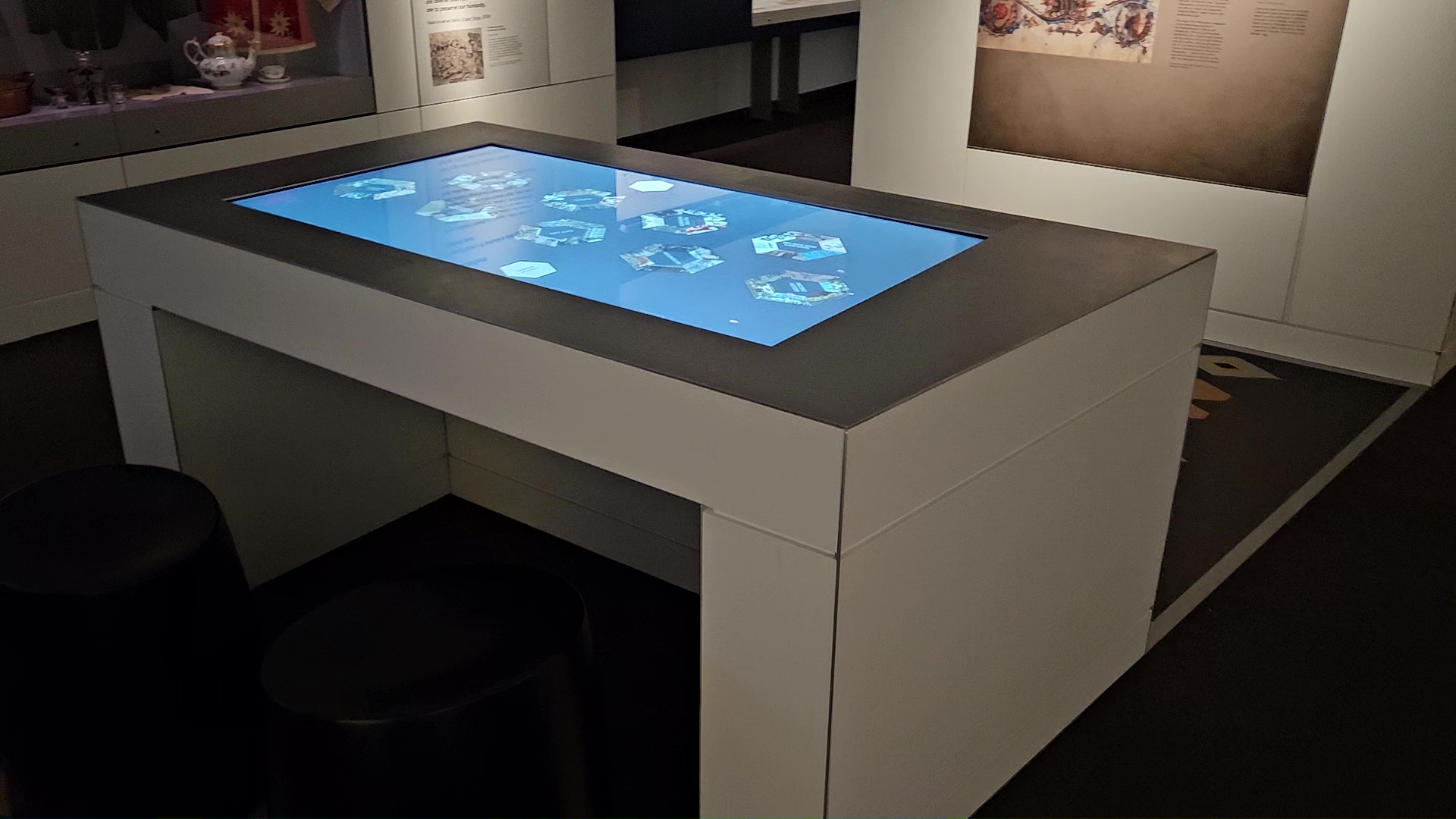
Pre-war Jewish Life interactive table.
To discuss each multimedia in detail would be a series of its own, but the work of the small museum team was phenomenal in bringing these into existence: beyond the usual curational and archival research, extensive time was needed to write and review content as it moved between platforms, find and access the rights to content, and to proof the large number of displays for each interactive. Much of this work was performed by Sandy Saxon and Fiona Kelman, alongside former CEO and curator Jayne Josem. The curatorial team had much more control over the physical displays, whilst the multimedia content went through various gatekeepers from Arek internally, and through the hardware and software design teams, including digital storytellers Sandpit.
Generally referred to by staff as ‘multimedia’ or ‘audio visual’, Jayne Josem describes the different types of displays of the permanent exhibitions as so:
- artefacts (e.g., archival footage and historical radio broadcasts)
- ‘label extenders’ (explaining content in the room, e.g., complementing the originally survivor-built Treblinka model)
- deep dives into artefact stories (e.g., Deportation Diary and Desperate Letters)
- scholarly deep dives into topics (e.g., Pre-war Jewish Life, Ghettos, The Camps)
- as art
- replicant survivor guide (In The Footsteps)
At the backend, the curatorial team use Pimcore which presents photographed objects and text in a modular assemblage – a very different interface to that which curators were familiar with in arranging physical displays.
I want to spend a little time focusing on two areas of the exhibition in a little more detail:
One of the biggest challenges for all Holocaust museums has always been how to introduce the diversity of pre-war Jewish life in order to demonstrate the human and cultural impact of the Holocaust. There are three multimedia displays in the Pre-war Jewish life gallery (here I want to focus on two of them in detail – the other offers exploration of the former synagogue of Czestochowa):
A triptych of archive footage fading in and out, mixing wider and close-up shots moving the visitor through a diversity of images of not only Jewish culture and communities but focusing in slow-moving footage on individuals.
This display reminds me of two earlier projects: the immersive projection in the Shoah exhibition at the Auschwitz-Birkenau State Memorial, which I’m sure uses some of the same – or at least very similar – footage moving through a range of European Jewish communities. The other, the Israeli film A Film Unfinished (2010), in which filmmaker Yael Hersonski slows down archive footage of the Warsaw Ghetto to encourage viewers to engage more closely with the individuals in the film, challenging the intentions of the perpetrator-aligned filmmakers.
An encyclopaedic interactive table on the diversity of Jewish life, culture and politics.
It took me 1.5 hours to go through all the content on this table – it really did provide a ‘deep dive’ into pre-war Jewish life. The table provides a simultaneous private and social experience. You sit at the table with up to three other participating visitors (whilst further people can look over your shoulders). Each of you can pull one of the many thematic hexagons across the table to the area right in front of you which then prompts it to open a swipe and click through display.
In this, and the synagogue interactive, there is room for more playful engagement than in the later galleries. You can hear and try and repeat the sound of Yiddish words and write your initials in Hebrew. Later touch screens focus more on the geographical scope of the Holocaust and contemporary genocides, or on objects, such as letters by those trying to flee Nazi-occupied territories.
Threaded through the museum is another multimedia exhibit In The Footsteps (the only one consisting of multiple iterations)– kiosks where visitors can use NFC-enabled postcards of specific survivors (picked up at the entrance to the exhibition). The historical feel of the slightly sepia postcards with black-and-white photographs of the survivors is resonant of the 1930s aesthetics of the earlier StoryPods project, but here the kiosks themselves look modern. You push your postcard into a slot in each kiosk to hear more from the particular survivor whose postcard you’ve selected regarding their experience related to the specific gallery you are in.
In the Footsteps is reminiscent of the historical kiosks and computer setups at the Simon Wiesenthal Centre, Los Angeles and the United States Holocaust Memorial Museum, Washington DC, also designed to encourage visitors to follow the story of one individual – personalising genocide and resisting the abstraction of ‘6 million’. Whilst StoryPods was visitor-led and allowed them to explore multiple different survivor narratives, with In The Footsteps, visitors must still take the initiative to select a postcard and commit to inserting it at each kiosk. However, here the screens themselves are not interactive. Once it is activated by the postcard, the visitor adopts the position of viewer and listener and is encouraged by the front-of-house staff checking tickets to take a single postcard, thus reinforcing the individual narrative of survivor tours. Whilst survivor-led tours are still part of the museum’s activities, they are not as regular or as varied as they were when StoryPods was introduced, thus In The Footsteps seems very much designed as Josem described: to serve as ‘replicant survivor guides’. It is a technical answer to the question: how do we keep the survivor community at the centre of the museum?
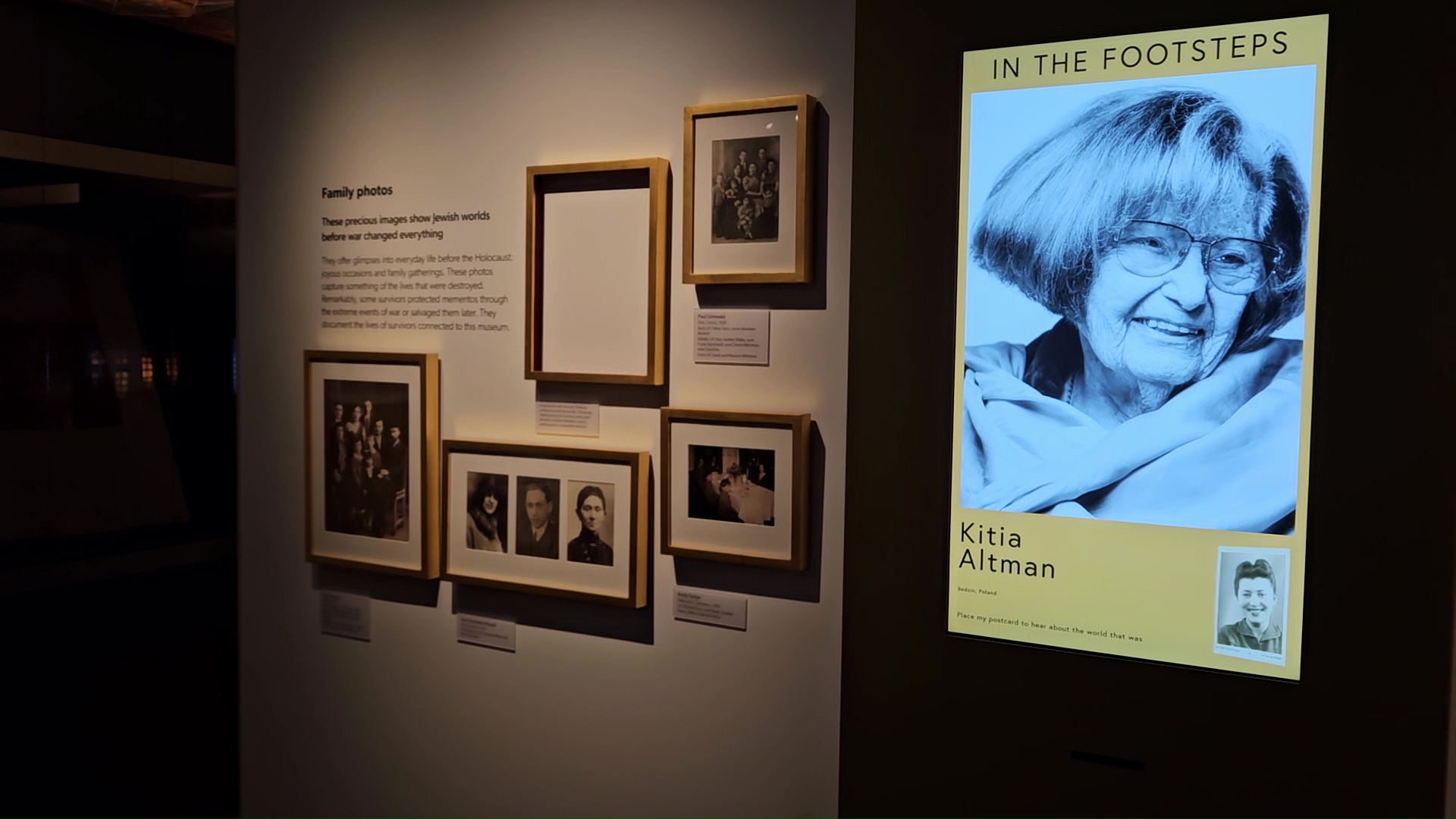
In the Footsteps kiosk
Whilst for StoryPods, the curatorial team had completed permission forms with all of the featured survivors, this was not possible for In The Footsteps and other interactives because some of the featured survivors are no longer alive. This demonstrates an increasing challenge for Holocaust museums – what right(s) do we have to use recorded survivor testimony in digital formats of the future which they could never have imagined existing?
The VR Suite
In 2016, the centre was approached by local filmmaker Danny Ben-Moshe to create a VR film of survivor testimony. Staff were hesitant at first – it seemed like an approach that put the medium before the content, and those who had not experienced VR before associated it with gaming. The film was created with limited production funding, with Jayne Josem, a two-person film crew, and survivor John (Saja) Chaskiel and his wife going to Poland and Germany. It then took several years to find follow-up funding for post-production. The final film Walk with Me is now on display in a dedicated VR suite. It is bookended by support from one of the Museum’s front-of-house staff, who on- and off-boards visitors from the experience, including introducing how the technology works. Visitors sit in wheely chairs with Head-Mounted Displays (HMDs) and headphones, so like the interactive table of pre-war Jewish life, it is both a social and very personal experience.
Walk with Me is very much a 360-degree film which visitors are invited to view, rather than ‘interact’ with. It follows John’s story from his pre-war dwellings through his transit and camp experiences to his arrival in Melbourne, reiterating the USC Shoah Foundation’s typical narrative structure of testimony recording and the happy ending of arrival in the new country as seen in James Moll’s The Last Days (1998) albeit incorporating Ben-Moshe’s more confrontational filmmaking style (e.g., knocking on the door of John’s old home unannounced and seeing what happens!). This use of VR is a common approach seen at Holocaust memorial museums, especially those distant from historical sites of Holocaust violence.
An Award-Winning Children’s Exhibition
In another separate space designed for young visitors – aged 10+ – is the exhibition Hidden: Seven Children Saved designed with Art Processors. Hidden integrates digital technologies within the physical exhibition even more than the permanent exhibition (in fact, the whole museum raised challenges for our walkthrough methodology, which had historically depended on screen recordings!). Following the logic of In The Footsteps, visitors to Hidden receive a lanyard with a drawing of a specific survivor as a child accompanied by their name. The whole experience is moderator-led, with one of the front-of-house team introducing each display and triggering audio-visual content with an i-Pad. The centre piece of Hidden is a physical diorama. At first, I thought this presented a sort-of ‘nowhere European place’, but I was informed that it carefully incorporates architecture of the different cities and towns in which the seven featured survivors lived at the outset of war. Digital projection weaves into the diorama (when triggered by the guide): a narrative plays out in the skies above it, whilst silhouetted figures move across the front of the diorama bringing European communities to life, whilst retaining a trace-like sense to their presence (as if they are already potentially absent). Once visitors have been given an introductory scene to watch collectively, they are invited to come closer to the model, don headphones and peer into the window of one of the buildings where three animated sequences play out related to the individual whose name hangs around their neck on the lanyard.
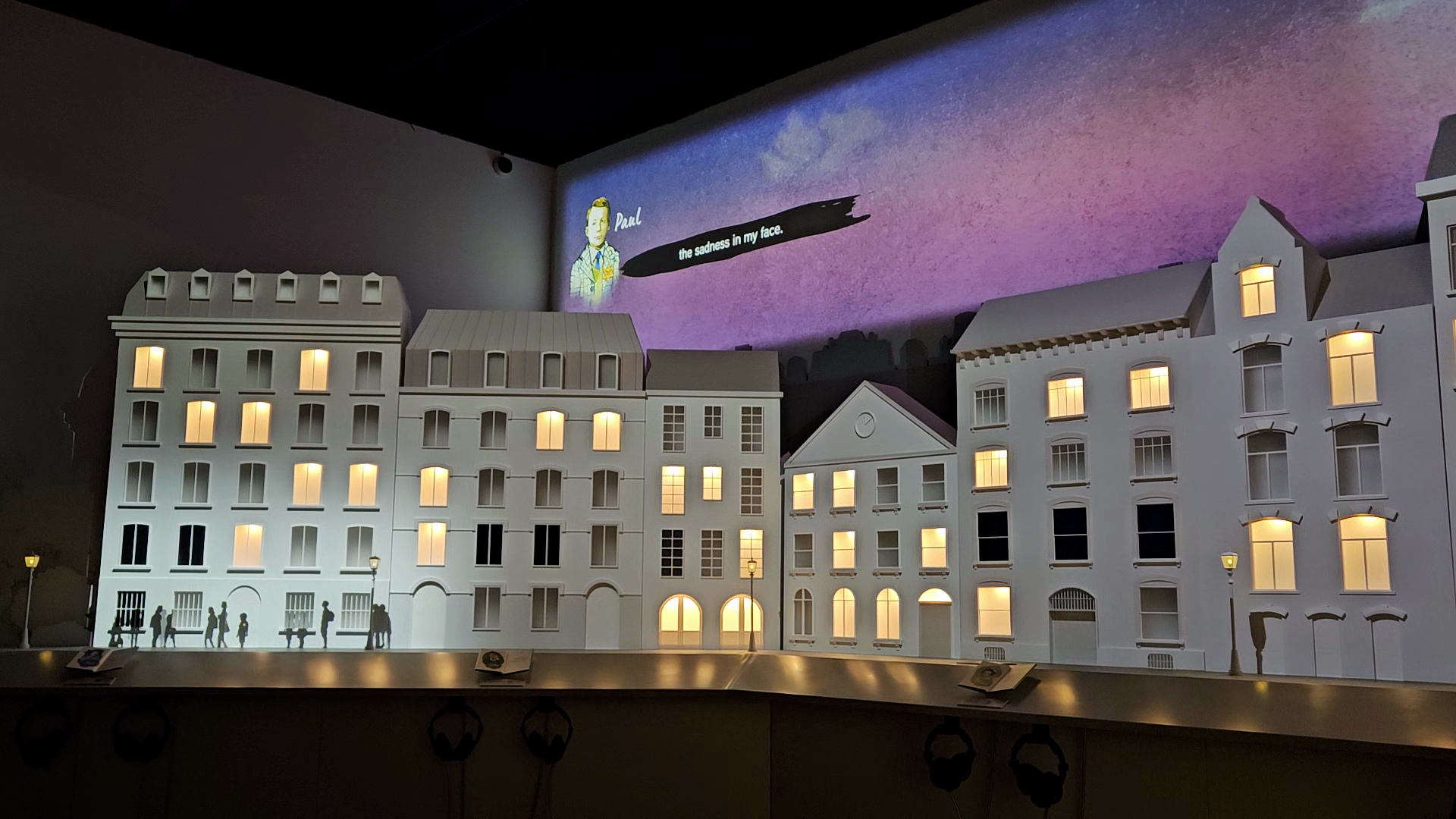
A snippet from the diorama walkthrough.
Age-appropriateness remains a debate in Holocaust education, specifically the question: at what age is it ethical to introduce children to this traumatic and violent past?
Hidden uses animation, relatable Australian accents, and a constellation of objects, text, and interactive displays – combining both physical features and animation (for example, in the second room, visitors can look into a mirror and see an animated sequence). All of this is underpinned by the individual testimonies of survivors who experienced Nazi occupation and were hidden as children and later came to settle in Melbourne. The final gallery in the exhibition space reveals more about their lives in the city, but not before a moving, yet simple physical memorial names their relatives who did not survive. After the exhibition, all visitors, particularly the school groups, can watch video testimony from these survivors and the latter can participate in reflective learning activities. This brings the different individual narratives into dialogue with one another and encourages shared learning – as each pupil then has the opportunity to represent for the survivor with whom they engaged in the exhibition, sharing their experience with their peers: once again, weaving the personal and social together.
Whilst survivor testimony is at the fore of the museum’s work, it has not adopted the USC Shoah Foundation’s Dimensions in Testimony programme as Sydney Jewish Museum has (see two examples of this integration here and here). Nevertheless, the essence of asking questions to survivors is foregrounded throughout, for example, in Ask a Survivor, and personal encounters with individuals which threads through Hidden, In the Footsteps, and Walk with Me.
To sum up, I was struck by six things at the Melbourne Holocaust Museum:
- the recording of testimony a-new, in short-form for exhibition ad pedagogical purposes, resulting in a careful curation of testimony on display
- the institution’s (as centre then museum) long commitment to ‘multimedia’ and ‘audio visual’ displays, and the fact that staff tend to use these continuity terms – which bridge across earlier electronic forms and contemporary digital – rather than ‘digital media’
- the weaving of digital content (especially in Hidden) into the physical display so that they work as one – this was quite unique compared to other Holocaust museums I have visited, where digital content often feels like an add on or extension
- the centrality of the survivor voice and experience is essential to its remit, and this is clearly demonstrated throughout all of its digital content
- the shaping of visitor experience so that it has moments which are simultaneously personal and social
- its commitment to archiving its historical physical exhibition through digital means and trying to capture the spatial and human elements of museum experience in this.
The virtual tour of the old Jewish Holocaust Centre’s permanent exhibition confronts us all with the question: how do we archive physical exhibitions and if we are not, what learning have we lost in relation to curatorial experiences and histories?
*All photographs are taken from our walkthrough material, or from the Melbourne Holocaust Museum or Sandpit’s websites.
Want to know more?
Spotlight on Zanis Lipke Memorial
Finding Virtuality in Virtual Holocaust Museum
Walkthroughs of the digital experiences and interviews with staff from the Melbourne Holocaust Museum will be available in our living database-archive, launching in late 2025.